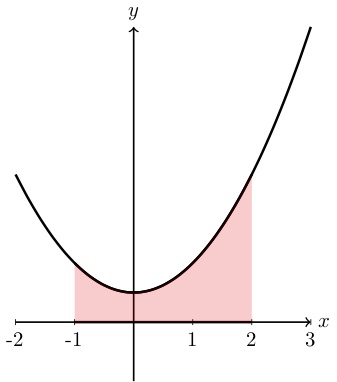Motivating Questions
- If we have a function given by a formula, is there a way to write down the antiderivative?
- How can we find the area between two curves?
unl.yuja.com/V/Video?v=7114362&node=34303293&a=20168581&autoplay=1unl.yuja.com/V/Video?v=7114360&node=34303269&a=128183455&autoplay=1unl.yuja.com/V/Video?v=7114361&node=34303267&a=82839716&autoplay=1unl.yuja.com/V/Video?v=7114363&node=34303253&a=49374719&autoplay=1| given function, \(f(x)\) | antiderivative, \(F(x)\) |
| \(k\text{,}\) (\(k\) is constant) | |
| \(x^n\text{,}\) \(n \ne -1\) | |
| \(\frac{1}{x}\) | |
| \(\sin(x)\) | |
| \(\cos(x)\) | |
| \(\sec(x) \tan(x)\) | |
| \(\csc(x) \cot(x)\) | |
| \(\sec^2 (x)\) | |
| \(\csc^2 (x)\) | |
| \(e^x\) | |
| \(a^x\) \((a \gt 1)\) | |
| \(\frac{1}{1+x^2}\) | |
| \(\frac{1}{\sqrt{1-x^2}}\) |
| given function, \(f(x)\) | antiderivative, \(F(x)\) |
| \(k\text{,}\) (\(k \ne 0\)) | \(kx+C\) |
| \(x^n\text{,}\) \(n \ne -1\) | \(\frac{1}{n+1}x^{n+1}+C\) |
| \(\frac{1}{x}\) | \(\ln|x|+C\) |
| \(\sin(x)\) | \(-\cos(x)+C\) |
| \(\cos(x)\) | \(\sin(x)+C\) |
| \(\sec(x) \tan(x)\) | \(\sec(x)+C\) |
| \(\csc(x) \cot(x)\) | \(-\csc(x)+C\) |
| \(\sec^2 (x)\) | \(\tan(x)+C\) |
| \(\csc^2 (x)\) | \(\cot(x)+C\) |
| \(e^x\) | \(e^x+C\) |
| \(a^x\) \((a \gt 1)\) | \(\frac{1}{\ln(a)} a^x+C\) |
| \(\frac{1}{1+x^2}\) | \(\arctan(x)+C\) |
| \(\frac{1}{\sqrt{1-x^2}}\) | \(\arcsin(x)+C\) |
| given function, \(f(x)\) | antiderivative, \(F(x)\) |
| \(k\text{,}\) (\(k \ne 0\)) | \(kx+C\) |
| \(x^n\text{,}\) \(n \ne -1\) | \(\frac{1}{n+1}x^{n+1}+C\) |
| \(\frac{1}{x}\) | \(\ln|x|+C\) |
| \(\sin(x)\) | \(-\cos(x)+C\) |
| \(\cos(x)\) | \(\sin(x)+C\) |
| \(\sec(x) \tan(x)\) | \(\sec(x)+C\) |
| \(\csc(x) \cot(x)\) | \(-\csc(x)+C\) |
| \(\sec^2 (x)\) | \(\tan(x)+C\) |
| \(\csc^2 (x)\) | \(\cot(x)+C\) |
| \(e^x\) | \(e^x+C\) |
| \(a^x\) \((a \gt 1)\) | \(\frac{1}{\ln(a)} a^x+C\) |
| \(\frac{1}{1+x^2}\) | \(\arctan(x)+C\) |
| \(\frac{1}{\sqrt{1-x^2}}\) | \(\arcsin(x)+C\) |



